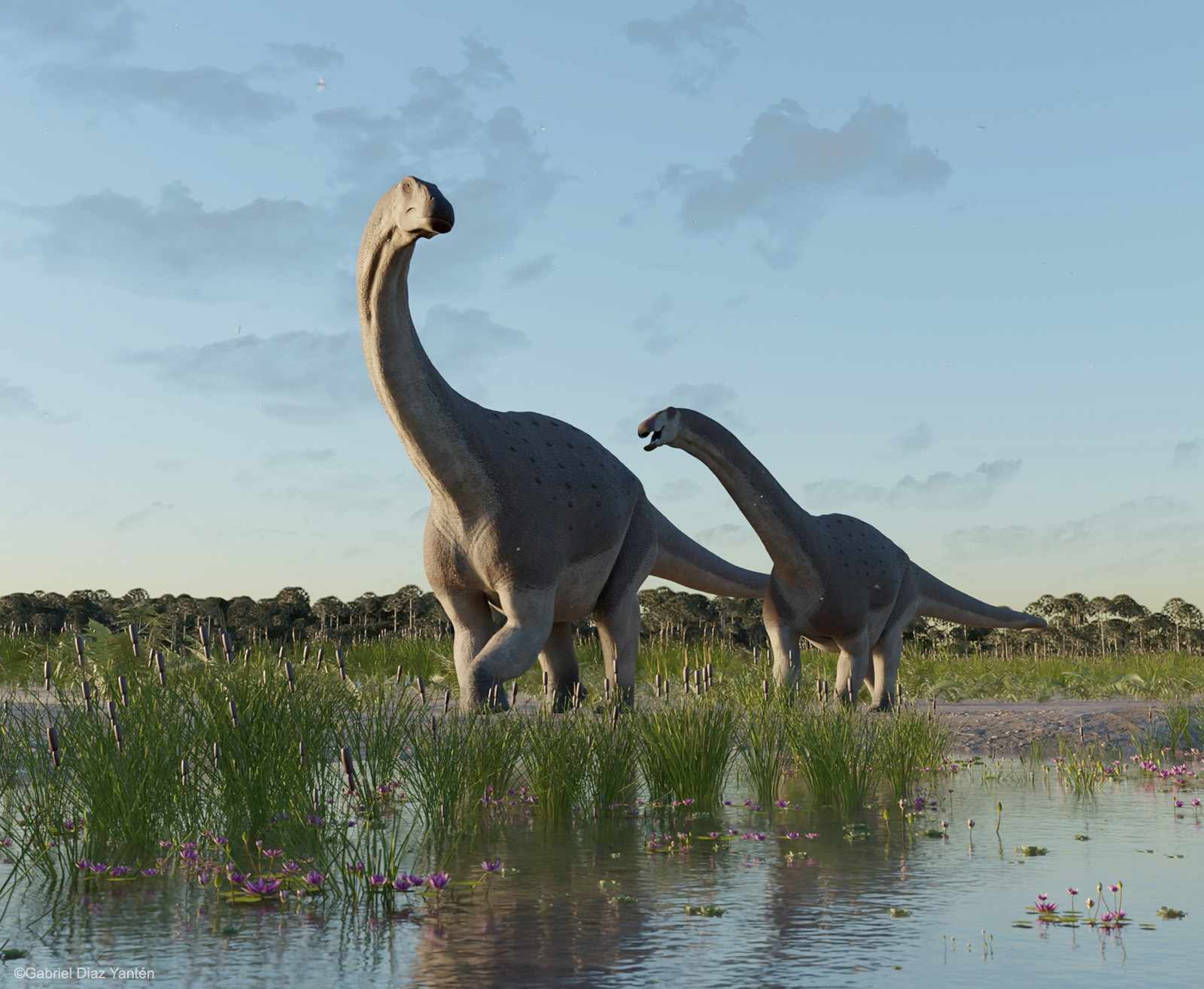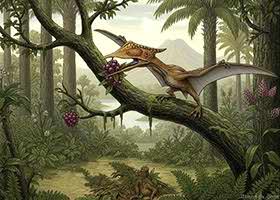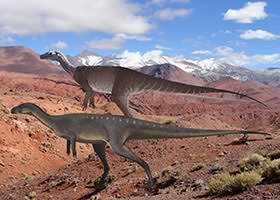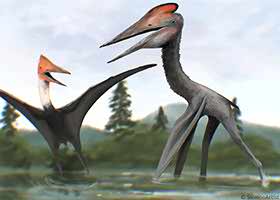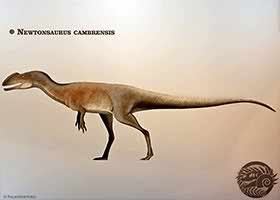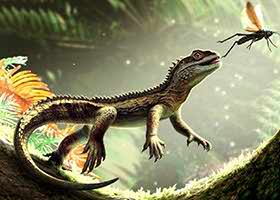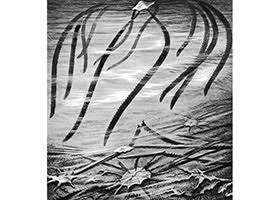
Ichnofacies, as groups of biogenic structures, reflect the reaction of animals to paleoecological conditions. Different environments influence trace formation in different ways. In marine settings, sedimentation and depth changes play major roles. In continental environments, temperature and moisture are key factors, whereasiIn subaqueous settings, oxygen levels, energy of deposition, and substrate type and consistency matter most.
Vertebrate and invertebrate ichnology developed as separate disciplines, largely because of fundamental differences in the morphology and behavior of track makers. For invertebrate traces, what the animal did is more important than what it looked like, especially how it interacted with the ground. But for vertebrate traces, the shape of the feet is key for classifying them. However, the behavior of the animal plays a lesser role and can sometimes make classification confusing.

Because of these differences, invertebrate ichnologists use an ethological approach, classifying traces by behavior. In contrast, vertebrate ichnologists prefer a bio-taxonomic approach, linking tracks to the animals that made them. Consequently, this distinction results in ethoichnofacies for invertebrates and biotaxoichnofacies for vertebrates.
Invertebrate Ichnofacies
Ichnofacies are recurring assemblages of trace fossils (ichnotaxa) that reflect specific environmental settings and span broad geological time ranges. Importantly, they highlight characteristic features shared by various ichnocoenoses. These trace fossil groupings do not occur randomly; rather, they form under comparable paleoenvironmental conditions. Factors such as substrate firmness, water depth and salinity, wave energy, currents, nutrient availability, oxygen levels, temperature, and light exposure all play a role in determining which organisms can inhabit a given environment.

Ichnofossils: 1—Caulostrepsis, 2—Entobia, 3—Circolites, 4—Trypanites, 5-6—Gastrochaenolites, 7—Diplocraterion, 8—Psilonichnus, 9—Skolithos, 10—Diplocraterion, 11—Thalassinoides, 12—Arenicolites, 13—Ophiomorpha, 14—Phycodes, 15—Rhizocorallium, 16—Teichichnus, 17—Crossopodia, 18—Asteriacites, 19—Zoophycos, 20—Lorenzinia, 21—Zoophycos, 22—Paleodictyon, 23—Taphrhelminthopsis, 24—Helminthoida, 25—Spirorhaphe, 26—Cosmorhaphe.
Researchers classify invertebrate ichnofacies into three main categories: softground marine, substrate-controlled, and continental ichnofacies. Examples of invertebrate ichnofacies in epicontinental basins of the past, from shallow to great depths: Teredolite, Skolithos, Cruziana, Zoophycos, Nereites. In shallow coastal zones, high-energy conditions dominate, while in deeper, shelf environments, low-energy conditions prevail.
Softground Marine Ichnofacies
Softground marine ichnofacies are trace fossil assemblages formed in unconsolidated marine sediments in muddy or sandy seafloor.
Shallow Water and Coastal Environments

Psilonichnus Ichnofacies. This ichnofacies is common in the intertidal zone (upper littoral and supralittoral), at the boundary of marine, lagoonal, and non-marine environments. Typically, firm ground environment: coastal barrier islands, coastal sand dunes, sandy plains, tidal flats, deltaic plains, estuaries, lagoons, and bays. The combination of terrestrial, semi-marine, and marine environmental conditions of the Psilonichnus ichnofacies indicates its transitional nature.
The Psilonichnus ichnofacies represents a low-diversity assemblage of vertical burrows with basal dwelling chambers (Macanopsis) and narrow inclined burrows of invertebrate animals (J-, Y-, and U-shaped) and is also characterized by root traces and footprints of terrestrial mammals. The environmental energy is low and increases only in the case of storm events. The sedimentation rate is low. Food is present in the form of detritus.

Trace fossils from the Psilonichnus ichnofacies are generally rare. However, notable examples have been found in several regions and time periods. These include the Jurassic of Scotland, the Eocene of Japan, and the Holocene and Pleistocene deposits along the Georgia coast. Additional occurrences come from the Late Pleistocene of Korea and the modern marine environment of Peixe Lagoon in Brazil.
The Middle Jurassic (Bathonian) Kilmaluag Formation on the Isle of Skye (Scotland) illustrates the Psilonichnus ichnofacies, as it preserves various types of burrows that semi-terrestrial crabs or shrimp created in a sheltered, shallow coastal-lagoonal environment with low salinity and freshwater influence.
Aulichnites, Cellicalichnus, Coenobichnus, Lockeia, Macanopsis, Protovirgularia, Psilonichnus, and rhizoliths define the ichnofacies.

Skolithos Ichnofacies. This ichnofossil association is inherent in an environment with the highest level of wave and current energy and is most characteristic of nearshore settings (shoreline, intertidal shallows, estuaries, and tidal deltas). Interestingly, in some cases, researchers have also found it in marine depths on deep-sea sand fans and in nonmarine settings (Buatois and Mángano, 2004). It also occurs on the tops of storm sand sheets and turbidity flows, and it appears in relatively high-energy fluvial-lacustrine deposits.

The substrate, as a rule, consists of moderately to well-sorted sands with variable rates of sedimentation and erosion. Softgrounds to stiffgrounds. Here, organisms mainly obtain their food from suspended particles. Filter-feeding organisms and passive predators, representing the majority of the population, build vertically oriented dwellings, often strengthened to some extent.
The Skolithos ichnofacies feature a low diversity of abundant vertical domichnia burrows (Skolithos, Diplocraterion, and Arenicolites), along with fodinichnia (Ophiomorpha) and fugichnia.

Dense aggregations of inhabitants of the Skolithos ichnofacies are called piperock. They represent simple, almost vertical tubes with smooth walls. They never branch or intersect. Piperock occurs in sandstones and coarse siltstones across all types of shallow marine facies. Historically, piperock is common for the Cambrian but occurs throughout the Paleozoic, decreasing in abundance after the Cambrian.

Researchers have documented the ichnofacies from the Vendian to the present day.1 Burrows: Diplocraterion, Monocraterion, Ophiomorpha, Arenicolites, Cylindrichnus, Rosselia, Macaronichnus, and Skolithos.

Cruziana Ichnofacies. Characteristic of low-energy environments of substrates in the sublittoral zone above the storm wave base and below the normal wave base. These are estuaries, lagoons, shelves, and some non-marine environments with low ichnodiversity. Semi-cohesive muddy substrates with interlayers of silt and sand.

Notably, this ichnofacies distinguished by a great diversity of trace fossils, especially in the Mesozoic and Cenozoic, and a huge intensity of bioturbation. Benthic organisms of the Cruziana ichnofacies use suspension (filter feeders) or sediment (sediment feeders) as a food source. The Cruziana Ichnofacies includes presumed trilobite trace fossils, structures formed by sessile cnidarians, and shallow burrows and trails of worm-like organisms. Predators and scavengers are also characteristic of this ichnofacies.

Inhabitants usually build shallow tunnel systems in which horizontal components predominate. Furthermore, in addition to traces of dwelling structures (domichnia), traces of crawling (repichnia) and resting traces (cubichnia) are very numerous here.
Examples of ichnofossils: Arthrophycus, Arenicolites, Asteriacites, Bergaueria, Chondrites, Cruziana, Curvolithus, Dimorphichnus, Diplichnites, Helminthopsis, Lockeia, Ophiomorpha, Phycodes, Phycosiphon, Protovirgularia, Rhizocorallium, Rosselia, Rusophycus, Teichichnus, and Thalassinoides.
Shelf and Deep-Water Environments

Zoophycos Ichnofacies. Ichnofacies primarily features complex fodinichnia (Zoophycos, and occasionally other deep-water traces, such as Thalassinoides) and pascichnia, created by deposit-feeding organisms, arranged in tiers.
The Zoophycos ichnofacies typically forms in calm, low-energy marine environments situated below the storm wave base, ranging from the outer shelf to bathyal zones or in sheltered settings. These environments feature soft substrates such as viscous muddy sediments or sandy layers. They often have low oxygen levels and a high content of organic material. In general, sedimentation rates are generally very low.
This ichnofacies can also develop in both shallow and deep marine settings, provided similar environmental conditions exist—for example, in lagoonal or deep-water habitats.

Biologically, it shows low ichnodiversity. Trace fossils present there mainly belong to the ethological classes pascichnia and complex fodinichnia. These include both simple and complex burrows produced by deposit-feeding organisms, frequently featuring horizontal to gently inclined spreiten structures. The most common trace fossils in this ichnofacies are Zoophycos and Chondrites (and sometimes other deep-sea traces such as Thalassinoides).

Paleogeographically, the Zoophycos ichnofacies indicates a transition from shallower marine zones in the Paleozoic to deeper environments in the Mesozoic and Cenozoic. It occurs from the Cambrian to the Recent.
The most common ichnogenera: Asterosoma, Chondrites, Helminthopsis, Ophiomorpha, Phycosiphon, Planolites, Scolicia, Thalassinoides и Zoophycos.

Nereites Ichnofacies. This ichnofacies is associated with flysch deposits and is characteristic of a calm but moderately oxygenated seafloor. It has a complex structure due to more or less regular disturbances of bottom communities by turbidite flows. Fine-grained, dense silts and clays, deposited from suspension and interbedded with turbiditic siltstones and argillites, contain these trace fossils. In addition, a very slow sedimentation rate.
This ichnofacies indicates deep-water environments, including the ocean floor and deep marine basins; paleodepths are usually bathyal to abyssal.

The Nereites ichnofacies is characterized by diverse meandering pascichnia (Nereites, Neonereites, and Helminthoidea), spiral pascichnia (Spirorhaphe), and net trace fossils, agrichnia (Paleodictyon and Spirodesmos), belonging mainly to the graphoglyptid group. Vertical burrows are almost completely absent. It appears starting from the Silurian period (though the ichnogenus Nereites dates back to the Cambrian).
The most typical components of the Nereites ichnofacies in fine-grained sediments are: Chondrites, Cosmoraphe, Desmograpton, Glockerichnus, Helminthoides, Helminthopsis, Helminthoraphe, Megagrapton, Neonereites, Nereites, Ophiomorpha, Paleodictyon, Phycosiphon, Protopaleodictyon, Scolicia, Spirodesmos, Spirophycus, Spirophyton, Spirorhaphe, Urohelminthoida, Zoophycos.
Continental Invertebrate Ichnofacies

The colonization of continental environments was associated with the development of vacant spaces. The non-marine fossil record begins in the Late Ordovician, but a significant invasion of non-marine environments began closer to the Silurian–Devonian transition with the appearance of mobile epifaunal arthropods (Diplichnites) in coastal marine and alluvial plain environments.
Paleozoic paleosols are still few, as are the finds of trace fossils within them. By contrast, Mesozoic examples are more abundant and better studied. Furthermore, the Cenozoic shows even better studied cases of finding trace fossils in paleosols.

Mermia Ichnofacies. The Mermia ichnofacies represent low-energy continental ichnofossil communities found in fully aquatic, nonmarine environments such as lakes and rivers. Softgrounds and soupgrounds, fine-grained, unconsolidated substrates, and low sedimentation rates characterize these settings. Usually, lake bottoms have good oxygen levels and remain permanently submerged, although they may occasionally experience episodic sedimentation.
Within this ichnofacies, trace fossils typically show a dominance of fine, sinuous, horizontal to subhorizontal trails. Mobile, worm-like organisms created these trails by crawling across the sediment surface. These traces are primarily related to grazing and feeding behaviors (pascichnia and fodinichnia) produced by deposit-feeding epifauna. Locomotion traces are present but less common.
First evident in the Carboniferous, the Mermia ichnofacies reflect a diverse and active benthic community that fed on detritus in subaqueous lake environments. Overall, moderate to high ichnodiversity and abundance, but with generally unspecialized grazing patterns, characterize it.
The typical ichnogenera are: Cochlichnus, Cruziana, Diplichnites, Glaciichnium, Gordia, Helminthoidichnites, Helminthopsis, Maculichnus, Mermia, Planolites, Treptichnus, Tuberculichnus, Vagorichnus, and Warvichnium.

Scoyenia Ichnofacies. Continental environments include coastal areas flooded by storm tides, lake and river systems, and humid or wet non-marine settings—whether shallow aquatic deposits that are occasionally exposed to air, or low-lying land surfaces that are periodically flooded.
In general, this ichnofacies is characterized by a low diversity of occasional vertical domichnia burrows (Skolithos, Diplocraterion, and Arenicolites), simple horizontal fodinichnia (Scoyenia, Taenidium, and Ophiomorpha), fugichnia, and repichnia produced by insects or freshwater shrimps (Cruziana, Isopodichnus).
These ichnofacies develop on stiffgrounds in low-energy conditions found between aquatic and terrestrial environments. Food is present as surface detritus.
Traces commonly occur in fluvial and lacustrine deposits, often forming in siltstones and sandstones within red-bed formations. Additionally, associated subaerial paleosols and eolian sands may also contain traces of dinosaurs and other tetrapods. An example is the Australian humid interdune Mereenie Sandstone of Silurian age (Lucas, 2024).
Characteristic ichnogenera: Acripes, Ancorichnus, Arenicolites, Beaconites, Camborygma, Cruziana, Diplichnites, Diplocraterion, Isopodichnus, Mirandaichnium, Ophiomorpha, Rusophycus, Scoyenia, Skolithos, Taenidium, Umfolozia.

Coprinisphaera Ichnofacies. Continental ichnofossil assemblages in paleosols. Stiffgrounds to firmgrounds. Typically, characteristic traces of life activity in modern and ancient soils in terrestrial conditions range from dry and cold to humid and warm climates associated with savannas, meadows, prairies, steppes, alluvial plains, and ephemeral floodplains.
Biogenic structures typically show low to moderate diversity and occur in high abundance. Frequently, they often consist of insect nesting structures, galleries, including the classic dung-beetle brood ball chambers of the genus Coprinisphaera, and specimens of Celliforma, representing the nesting cells of solitary bees (Bostelmann et al., 2014). Various hymenopterans, beetles, ants, termites, and plant root systems (rhizoliths) create these traces.

Meniscate burrows and mammal caves marked with scratches can also be present. In the Tertiary period, mammals mainly formed these, with reptiles contributing to a lesser extent. In older rocks, other vertebrates could be responsible. For example, therapsids in the Permian and Triassic may have created scratch-marked spiral domichnia attributed to Daimonelix or unnamed branched colonial dwelling networks.
Ethologically, nesting traces (calichnia) predominate in this assemblage. There is a relatively complex tiering structure, reflecting the variable depth of nests of hymenopterans, termites, and dung beetles.

The Coprinisphaera Ichnofacies encompasses the Termitichnus sub-ichnofacies. This sub-ichnofacies features assemblages with a predominance of termite nests within paleosols of closed forest ecosystems.
Characteristic ichnogenera: Attaichnus, Celliforma, Chubutolithes, Coprinisphaera, Eatonichnus, Ellipsoideichnus, Fontanai, Monesichnus, Palmiraichnus, Parowanichnus, Rosellichnus, Tacuruichnus, Teisseirei, and Uruguay.
Substrate-controlled Ichnofacies
Substrate type and consistency primarily determine and distinguish the traces found in the firmground (Glossifungites), woodground (Teredolites), and hardground (Trypanites, Entobia, and Gnathichnus) ichnofacies. Each of these ichnofacies represents a distinct type of substrate. This substrate underwent a degree of consolidation or hardening before trace-making organisms colonized it.

Glossifungites Ichnofacies. This is an ichnofacies of communities inhabiting firmground. Such settings include marginal shallow marine environments with moderate to high wave and current energy, and deltaic or estuarine erosional surfaces. These environments have dense but not fully lithified substrates, such as dewatered muds (firmground). Erosion in these areas often removes unconsolidated layers from the sediment surface. Food is predominantly suspended.

These substrates have some resistance to erosion. Organisms that can process very dense substrates using bioturbation methods inhabit them. Burrows in this ichnofacies are open (passively filled with material different from the matrix upon fossilization). Typically, the burrow walls are unlined and characterized by an abundance of scratches.
The Glossifungites assemblages typically form during periods of non-deposition or erosion.
Bioerosion is well-developed in this ichnofacies, mainly vertical and sub-vertical borings and burrows, some of which are quite complex (e.g., Spongeliomorpha). The Glossifungites ichnofacies feature domichnia (Glossifungites and Thalassinoides) and occasionally structures of plant root penetration.

Examples: Arenicolits, Begaueria, Chondrites, Conichnus, Cylindrichnus, Diplocraterion, Fuersichnus, Gastrochaenolites, Glossifungites, Planolites, Psilonichnus, Rhizocorallium, Skolithos, Spongeliomorpha, Taenidium, and Thalassinoides.

Teredolites Ichnofacies. Areas of the seabed with a high proportion of woody material (woodground), common in deltas, wooded swamps fed by small streams, low-lying intertidal zones, and other coastal environments. As a result, stable woody and peat substrates, marine omission surfaces on peat/coal deposits, and drifting wood slabs. Characteristic of erosion in peat-forming areas (e.g., on the estuarine margin, deltaic plain, or in back-barrier settings).
Some organisms are adapted to wood consumption. Accordingly, the Teredolites ichnofacies is characterized by a very monotonous ichnocoenosis—wood borings created almost exclusively by pholadid and teredinid bivalves (such as the modern shipworm Teredo). In freshwater ichnocoenoses, isopods and polychaetes predominantly carry out the boring.

The woodboring terenid bivalves (primarily Teredolites) in the present day only occur in brackish-water to fully marine environments. Non-marine wood borings also occur, but they are predominantly formed by insects and do not contain marine ichnogenera.
Since woody debris is more mobile and can be transported by water currents, only those assemblages associated with a substrate constitute the Teredolites Ichnofacies.

Boring traces first appear on fossil wood in the Devonian, but they remain rare until the Triassic. Even so, fossil examples of the Teredolites Ichnofacies exhibit low trace fossil diversity compared to modern ones.
Examples: Bankia, Caulostrepsis, Diplocraterion, Hemigraptus, Limnoria, Meandropolydora, Polydora, Rogerella, Teredolites, Thalassinoides, Trypanites, Xylonichnus.

Paleoscolytus Ichnofacies. It is the subaerial analog of the Teredolites ichnofacies. It includes non-marine fossil ichnocoenoses dominated by feeding traces and borings with low to moderate ichnodiversity. Woody, leafy, and bone substrates are characteristic of it. In particular, various organisms, mainly arthropods and microorganisms, colonize these “hardground” substrates in non-marine environments, and their activity causes bioerosion.
Trace fossils in plant substrates are diverse and date back to the Devonian period. These are mainly holes in wood, formed when organisms fed, reproduced, or sought shelter, along with feeding traces on leaves, such as mines and galls.

Cubiculum Ichnofacies. This ichnofacies includes non-marine subaerial environments associated with bone modifications. These are usually vertebrate bite marks, trampling and cut marks, arthropod borings, macroscopic and microscopic borings, and root corrosion. On occasion, other organisms that interact with bones do so less frequently and cause less damage. Overall, trace diversity is typically low to moderate, but the local abundance of traces can be high. Borings in bone first appear in the Middle–Late Triassic.

Notably, distinctive markings left by the trace maker’s mechanical activity—known as bioglyphs—can often be seen on the walls of these trace fossils. A representative example is Cubiculum ornatum, attributed to insects (likely sarcosaprophagous beetles) found in the dermal armor of glyptodonts from the Oligocene to Early Holocene of Uruguay and traces of bioerosion on titanosaur skeletal elements from the Late Cretaceous of Brazil.
These bioerosion fossil traces suggest periods of dry conditions in warm climates. The discovery of similar traces in the marine Camacho Formation indicates that these areas experienced subaerial exposure, consistent with marginal marine environments.
Ichnogenera: Amphifaoichnus, Brutalichnus, Clavichnus, Cubiculum, Cuniculichnus, Heterodontichnites, Karethraichnus, Knetichnus, Linichnus, Machichnus, Munitusichnus, Nihilichnus, Osteichnus, Osteocallis.
Hardground and Rockground
The Trypanites, Entobia, and Gnathichnus ichnofacies occur in true hardgrounds, which are fully lithified substrates such as carbonate rocks or shells. Tracemakers create these ichnofacies by boring into the hard surfaces, typically in marine settings. Researchers established the Entobia and Gnathichnus ichnofacies based on findings in the Pliocene of Rhodes.

Trypanites Ichnofacies. Characteristic of rockground and hardground with medium to high wave and current energy. Generally, typical environments are hard, lithified substrates such as surfaces on rocky shores, coastal boulders, limestone hardgrounds on the seabed, and organic substrates such as reefs and shell beds. Ancient examples rarely preserve traces of bioerosion that gastropods and echinoids left.
Additionally, euendoliths, which deeply penetrate lithified substrates, correspond to benthic organisms that create permanent dwelling structures (domichnia) in hard substrates and usually significantly bioerode the host rock.

Assemblages belonging to the Trypanites ichnofacies include various forms of dwellings. They can have sharply defined, unlined walls and a cylindrical, vase-shaped, teardrop-shaped, or U-shaped form. Filter feeders or predators, such as Trypanites, the bivalves Gastrochaenolites, and Ubiglobites, presumably created these dwellings. Irregular dwellings, such as Entobia, as well as irregular pits or furrows formed by barnacles, such as Rogerella, also occur. Borings are perpendicular to the substrate.
The assemblages include shallow anastomosing systems dug by sponges (Entobia), bryozoans, filter feeders, or passive predators. Furthermore, you can find scratches and raspings that algivorous organisms like sea urchins, chitons, or limpets produce. Food is predominantly suspended.

Usually, these assemblages show moderately low diversity, although the number of traces can be high.
Ichnogenera: Caulostrepsis, Conchotrema, Entobia, Gastrochaenolites, Maeandropolydora, Rogerella, Talpina, Trypanites, Ubiglobites.

Gnathichnus Ichnofacies. Found on rock surfaces in areas with low hydrodynamic energy, which can be lagoons, underwater caves, or rock outcrops at a considerable depth in the sea. The Gnathichnus ichnofacies encompasses ichnocoenoses associated with predominantly surface bioerosional structures, mainly on isolated clasts, boulders, shell accumulations, or on skeletons.
Most often, the traces typically consist of ordered “scratches” on the surface of clasts and rocks. Such traces result from living organisms scraping off the algal film from these rocks.


Traces of scrapers and borers on oyster Pycnodonte biauriculata, Marnes à Pycnodonte biauriculata Formation, Late Cenomanian, Le Mans, Sarthe Department, France.
Left: Echinoid scraping traces Gnathichnus pentax; these rather large G. pentax tend to concentrate around the entobian apertures.
Right: Possible foraminiferan boring Dendrina anomala. © Breton et al.
Usually, the most numerous trace fossils are Gnathichnus and Radulichnus, formed because of the grazing activity of echinoids and polyplacophorans on algae and other microorganisms covering the surface of shells. Other bioerosion traces include polychaete dwellings (domichnia), sponge boring systems, rare bryozoan borings, predatory structures (praedichnia), and pits for foraminifera attachment (fixichnia).

These assemblages of surface sculptures occur in short-lived bioerosion situations, on shell surfaces, and on hardgrounds buried early because of sedimentation, as they have a very low preservation potential. The Gnathichnus Ichnofacies recurs from the Jurassic to the Holocene, as studies have shown.2
Ichnogenera: Caulostrepsis, Centrichnus, Entobia, Gnathichnus, Maeandropolydora, Oichnus, Radulichnus, Renichnus, Pinaceocladichnus.

Entobia Ichnofacies. This ichnofacies pertains to rockground surfaces, littoral rocky shores, hard carbonate substrates (such as corals, rhodoliths, carbonate cements, and hardgrounds), or an accumulation of borings on calcareous shells (shellground) in environments with strong waves and currents. Thus, this is a typical “surf zone” facies. It is rich in various forms of dwelling burrows of filtering organisms. The tracemakers are most often bivalves, sponges (clionid sponges), and worms.
The Entobia ichnofacies corresponds to long-term bioerosion of a lithified surface (usually carbonate) during periods of non-deposition or reduced sediment input. This allows for the excavation and maintenance of deep-tier dwelling structures.

A—Amphidonte obliquata; note that both the substrate as well as the fixed valves are perforated by the sponge boring Entobia isp.; one of the A. obliquata shells preserved two articulated valves. B—Sponge boring Entobia isp., inner side of a LV; note the swellings and the discolored areoles around the apertures, indicating a synvivo entobian infestation. © Breton et al.
Gibert et al. (1998) confirm the presence of the Entobia ichnofacies on rocky shores from the Jurassic to the Holocene. Despite its wide range of occurrence, the Entobia ichnofacies demonstrates ethological and morphological correspondence with the existing Trypanites ichnofacies, so we can consider them equivalent.
Ichnogenera: Caulostrepsis, Entobia, Gastrochaenolites, Maeandropolydora, Trypanites.
Suggested Additional Ichnofacies
Researchers have proposed several alternative ichnofacies to refine or expand upon the traditional Seilacherian model.

Rusophycus Ichnofacies. This ichnofacies suggested for fluvial and lacustrine settings features arthropod resting and locomotion traces, such as Rusophycus. However, it is currently indistinguishable from the widely accepted Scoyenia ichnofacies.
Fuersichnus Ichnofacies: Proposed for lacustrine environments below the fair-weather wave base, based on occurrences of Fuersichnus in non-marine settings. Like the Rusophycus ichnofacies, it does not presently show sufficient differentiation from the Scoyenia ichnofacies.
Arenicolites Ichnofacies: Some authors have advocated replacing the Scoyenia ichnofacies with this variant, although consensus is lacking.
Subdivision of Nereites Ichnofacies: Researchers have recommended a division into separate Nereites and Palaeodictyon ichnofacies to represent ichnodiversity in deep marine environments.
Researchers have suggested additional ichnofacies for continental settings.



Termitichnus, Celliforma, and Octopodichnus–Entradichnus Ichnofacies. Scientists propose these as evidence of invertebrate activity in inland eolian dune systems. These suggestions, however, come from limited studies and are therefore preliminary. The broader utility and applicability of these suggestions are still under debate. Moreover, the Termitichnus and Entradichnus ichnofacies seem to be the same as the Scoyenia ichnofacies, while Octopodichnus usually belongs to the Chelichnus ichnofacies.
There is also a further suggestion of non-Seylacherian ichnofacies:

Curvolithus Ichnofacies: Recognized in deltaic systems and shallow marine facies of normal or slightly brackish salinity, this ichnofacies may ultimately represent a variant of the Cruziana ichnofacies.
Vertebrate Ichnofacies
Vertebrate ichnofacies show recurring assemblages of trace fossils connected to specific ancient environments. These assemblages reflect ecological patterns that environmental conditions and the evolution of vertebrate faunas influenced, rather than strict definitions based on time or geography.3
These vertebrate trace fossils include footprints, trails, burrows, and predation marks, as well as gastroliths, eggshells, and coprolites.
There are five original vertebrate ichnofacies (or tetrapod ichnofacies) for non-marine environments: Chelichnus, Grallator, Batrachichnus, Brontopodus, and Characichnos.
Early Tetrapod Ichnofaunas
The Chelichnus and Batrachichnus ichnofacies are mainly associated with early terrestrial environments. In the Paleozoic, they encompass all Carboniferous-Permian tetrapod ichnofaunas. Thus, there are only two non-marine vertebrate ichnofacies in the Late Paleozoic, in contrast to the more numerous invertebrate ichnofacies in marine deposits of the same time.
Permian tetrapod footprints represent biostratigraphically distinct groups, including small amphibians, the Early Permian pelycosaur group, and the Middle-Late Permian therapsid group.

Chelichnus Ichnofacies. Low diversity ichnofauna of plantigrade tetrapod tracks (less than four to five ichnogenera) having a similar shape with nearly equal manus and pes imprints and short digit impressions. Also includes mammal and reptile burrows. Desert, fluvial, and plain environments: arid continental deposits in eolian sand dunes, unconsolidated, coarse-grained sands.

The tracks belong to various tetrapods, including pelycosaurs (e.g., Chelichnus), therapsids, and reptiles. Notably, Permian eolian deposits of the Chelichnus ichnofacies, regardless of their age, contain similar tetrapod ichnofossils across all sites.
The ichnofacies occurs from the Late Paleozoic (Early Permian) to the Early Jurassic but is most common in the Permian–Late Triassic. It was previously called the Laoporus Ichnofacies. An example of the Chelichnus ichnofacies: the well-known eolian Coconino Sandstone strata in Arizona (Late Kungurian).
Similar ichnofacies recur in similar environments across time. For instance, Chelichnus ichnofacies (eolian, arid) appears in both the Permian and later Mesozoic dune systems, though the exact ichnotaxa may differ.

Chelichnus Ichnofacies includes Brasilichnium ichnocoenoses (Late Triassic–Early Jurassic). Common Ichnogenera: Brasilichnium, Chelichnus, Dromopus.4

Batrachichnus Ichnofacies. Most tracks belong to quadrupedal predators; diversity is moderate to high (4–8 ichnogenera). This ichnofauna represents redbed depositional settings, low-lying and more humid lands, shallow lakes, tidal flats, and fluvial plain environments.

Among the typical trackmakers were small temnospondyls (e.g., Batrachichnus), araeoscelids, diadectomorphs, captorhinomorphs, seymouriamorphs, procolophonids, and pelycosaurs. Later, in the Middle and Late Permian, therapsids, pareiasaurs, and eosuchians predominated. Tetrapod footprints of the Batrachichnus ichnofacies have a broad, uniform composition, and ichnodiversity is much higher than in the Chelichnus ichnofacies.
The Batrachichnus ichnofacies is a consistent group of tetrapod footprints found at numerous locations across the Americas and Eurasia, representing a single biostratigraphic assemblage.


It is widespread from the Early Carboniferous to the Cretaceous (peaking in the Permian–Early Jurassic). This ichnofacies includes such ichnocoenoses as Chirotherium (Early–Middle Triassic), Apatopus (Late Triassic), Amphisauropus (Lower Permian), Pteraichnus (Upper Jurassic–Cretaceous), and Ichniotherium (Lower Permian).5
Common ichnotaxa include Amphisauropus, Apatopus, Batrachichnus, Chirotherium, Dicynodontipus, Dimetropus, Dromopus, Erpetopus, Gilmoreichnus, Hyloidichnus, Ichniotherium, Isochirotherium, Limnopus, Lunaepes, Merifontichnus, Pachypes, Pteraichnus, Rhynchosauroides, Rotodactylus, Synaptichnium, Tambachiehnium, and Varanopus.
Dinosaur- and Mammal-dominated Ichnofaunas
These ichnofacies extend from the Late Paleozoic to the Cenozoic but are more typical of Middle and Late Mesozoic terrestrial and coastal environments with dinosaur or archosaur activity.

Characichnos Ichnofacies. Ichnofauna of medium diversity. Most tracks are swimming traces (parallel scratch marks) and fish swimming trails (Undichna). Typically, partially buoyant tracemakers mostly left such traces when their limbs did not fully touch the substrate during locomotion. Subaqueous environments: shallow lakes, estuaries, river deltas, and tidal environments.

This ichnofacies may include swimming traces of crocodiles and marine and freshwater turtles. For example, crocodile swimming traces (e.g., Albertasuchipes, Hatcherichnus) consist of two to five elongated, straight, and parallel (sometimes gently curved) scratch tracks (claw marks). Well-preserved claw marks show a pointed and curved morphology. Subtle webbing traces are distinguishable between digital scratches in some cases. Crocodile swimming traces are clearly less numerous than sauropod or hadrosaur tracks in lagoonal and fluvial conditions, respectively.
The ichnofacies is most characteristic of the Jurassic period but also occurs in the Cretaceous and even Cenozoic. Specifically, Characichnos Ichnofacies include Characichnos (Early Jurassic–Cretaceous), Serpentichnus (Permian), Hatcherichnus, and Chelonichnium ichnocoenosis (Upper Jurassic).6 Common Ichnotaxa: Albertasuchipes, Batrachichnus, Characichnos, Chelonichnium, Emydhipus, Hatcherichnus, Lunichnium, Puertollanopus, Serpentichnus, Undichna.

Brontopodus Ichnofacies. Includes an ichnofauna with medium to high diversity (4–8 ichnogenera), in which the largest number of tracks belongs to terrestrial herbivores, with a smaller presence of carnivores (less than 10%).

Sauropods dominate the ichnoassociation, with many large theropods, small theropods, and ornithopods. Sauropod traces become abundant as early as the Late Jurassic. In general, turtle and pterosaur tracks and the sauropod ichnogenus Parabrontopodus are more common in the Jurassic and Brontopodus in the Cretaceous. As a recurring ichnofacies, the Brontopodus ichnofacies includes large terrestrial vertebrates, spanning the Mesozoic to the Cenozoic, but the tracemakers change (e.g., sauropods → proboscideans).
The inferred habitat is coastal plains, marine coastlines, lagoons, and some lakeshores.
Age: Late Permian to Recent (Late Jurassic–Late Cretaceous).

This ichnofacies includes such ichnocoenoses as Pachypes (Permian), Brontopodus (Middle Jurassic-Late Cretaceous), Parabrontopodus (Early Jurassic-Early Cretaceous), Dicynodontipus (Early Triassic), Therapsipus (Middle Triassic), Brachychirotherium (Late Triassic), Evazoum (Late Triassic), Dinehichnus (Late Jurassic), Tetrapodosaurus (Cretaceous), and Ceratopsipes (Cretaceous).
Frequently encountered ichnogenera: Amblydactylus, Brontopodus (wide-gauge trackway, large manus), Carichnium, Ceratopsipes, Charirichnium, Chelonichnium, Dicynodontipus, Dinehichnus, Evazoum, Lunaepes, Pachypes, Parabrontopodus (narrow-gauge trackway, small manus), Planipes, Rhynchosauroides, Tetrapodosaurus, and Therapsipus.

Grallator Ichnofacies. The Grallator ichnofacies is marked by a well-differentiated and moderately to highly diverse ichnofauna, typically including 5–8 ichnogenera. Tridactyl tracks made by avian and non-avian theropods, along with other habitual bipeds, dominate it. Also, frequently present are tracks of bipedal and quadrupedal ornithischians, prosauropods such as Otozoum and Navahopus7, sauropods, small crocodylomorphs like Batrachopus, and herbivorous mammals.
This ichnofacies is typically associated with humid environments along lake margins. In the Cenozoic, examples include a high abundance of shorebird tracks, leading to the alternative name “shorebird ichnofacies.”
While most characteristic of the Triassic–Jurassic interval, the Grallator ichnofacies span from the Late Triassic to the present. Notable ichnocoenoses within this ichnofacies include: Grallator (Late Triassic), Eubrontes (Early Jurassic), Carmelopodus (Middle Jurassic), Avipeda, and Jindongornipes (Cretaceous).
Some researchers also include the Megalosauripus ichnocoenosis (Middle to Late Jurassic and Cretaceous), especially for its biostratigraphic relevance in North America near the Oxfordian–Kimmeridgian boundary.
Common ichnotaxa in this ichnofacies include: Anchisauripus, Atreipus, Avipeda (shore bird), Batrachopus, Brachychirotherium, Brasilichnium, Carmelopodus, Eosauropus, Eubrontes, Grallator, Jindongornipes (bird tracks), Koreanoformis, Megalosauripus, Moyenisauripus, Otozoum, Rhynchosauroides, and Therangospodus.
Other Proposed Vertebrate Ichnofacies
Two more vertebrate ichnofacies are sometimes proposed, but they remain controversial due to their limited geographic and stratigraphic distribution, as well as insufficient ichnodiversity: the Carichnium ichnofacies and the Pteraichnus ichnofacies.

Carichnium Ichnofacies. This ichnofacies features Carichnium tracks, attributed to large non-hadrosaurian ornithopods from the Early Cretaceous. Lacustrine, floodplain, and coastal plain deposits commonly preserve their characteristic morphology and recurring assemblages of ornithopod tracks. However, this ichnofacies has not gained widespread acceptance due to its limited distribution and overlap with other better-known ichnofacies, such as the Grallator or even Avipeda ichnofacies. The ichnocoenosis often includes tracks of large bipedal herbivores but lacks the ichnodiversity typically required to justify a separate ichnofacies.

Pteraichnus Ichnofacies. This ichnofacies represents assemblages of pterosaur tracks, primarily the ichnogenus Pteraichnus. Usually, they occur in Late Jurassic and Cretaceous shallow or marginal marine deposits, on tidal flats exploited by pterosaurs. However, pterosaur track assemblages are rare and often preserved in association with tracks of large theropods, such as Therangospodus and Megalosauripus, as well as sometimes with bird tracks. The limited ichnodiversity and frequent overlap with other marine or marginal ichnofacies (e.g., Nereites or Grallator in transitional facies) hinder the recognition of a separate, independent ichnofacies and its wider acceptance.
In both cases, these proposed ichnofacies do not currently meet the criteria of recurrence and diversity that typically define recognized ichnofacies. Researchers typically define them using a single or limited number of ichnogenera, and they appear inconsistently across different depositional systems. Thus, it is better to view them as ichnocoenoses, which are specific assemblages of trace fossils, rather than fully established ichnofacies.
- Mary L. Droser, 1991. Ichnofabric of the Paleozoic Skolithos Ichnofacies and the Nature and Distribution of Skolithos Piperock ↩︎
- Jordi M. de Gibert, Rosa Domènech, and Jordi Martinell, 2007. Bioerosion in shell beds from the Pliocene Roussillon Basin, France: Implications for the (macro)bioerosion ichnofacies model ↩︎
- Lockley et al. 1994; Hunt & Lucas, 2007. ↩︎
- The ichnogenus Dromopus is included according Lockley et al., 1994; McKeever and Haubold, 1996; Lucas and Hunt, 2006. ↩︎
- Giuseppe Santi, 2008. The reality of the «Batrachichnus ichnofacies»: Proof from the Lower Permian of the Orobic and Trompia basins (South-Alpine region, Northern Italy). ↩︎
- Hunt and Lucas, 2006. Tetrapod Ichnofacies of the Upper Jurassic Morrison Formation, Western United States. ↩︎
- Milàn et al. (2008) attributed it to a prosauropod. ↩︎




